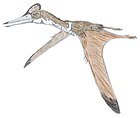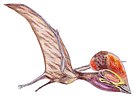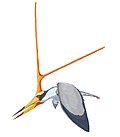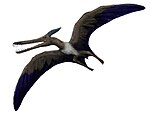Propterodactylus
| Propterodactylus | |
|---|---|

| |
| Holotype specimen | |
| Scientific classification | |
| Domain: | Eukaryota |
| Kingdom: | Animalia |
| Phylum: | Chordata |
| Order: | †Pterosauria |
| Clade: | †Pterodactyliformes |
| Clade: | †Caelidracones (?) |
| Suborder: | †Pterodactyloidea (?) |
| Genus: | †Propterodactylus Spindler, 2024 |
| Species: | †P. frankerlae
|
| Binomial name | |
| †Propterodactylus frankerlae Spindler, 2024
| |
Propterodactylus (meaning "before Pterodactylus") is an extinct genus of transitional monofenestratan pterosaurs from the Late Jurassic Painten Formation of Germany. The genus contains a single species, P. frankerlae, known from a complete articulated skeleton. Before its naming, Propterodactylus was referred to as the "Painten pro-pterodactyloid" in the scientific literature.
Discovery and naming
[edit]The Propterodactylus holotype specimen, DMA-JP-2011/006, was discovered in April 2011 in the Rygol lime works quarry of the Painten Formation (Ulmense subzone) near Painten in Bavaria, Germany. The nearly-perfect specimen consists of an articulated complete skeleton with preserved soft tissues.[1][2]
In 2024, Frederik Spindler described Propterodactylus frankerlae as a new genus and species of monofenestratan pterosaur based on these fossil remains. The generic name, Propterodactylus, combines the Ancient Greek suffix "προ-" ("pro-"), meaning "before", with the genus name Pterodactylus (derived from Greek words meaning "wing digit"). As such, the name references its position as a "forerunner" to the Pterodactyloidea, as well as its long-standing nickname as the "Painten pro-pterodactyloid". The specific name, frankerlae, honours Petra Hahn, née Frankerl, the deceased wife of Stephan Hahn, the discoverer of the Propterodactylus holotype.[1]
Description
[edit]The holotype specimen of Propterodactylus belongs to either a juvenile or subadult individual. As such, it had not reached full skeletal maturity. The lack of fusion in several skeletal elements, such as the synsacrum, scapulocoracoid, carpals, and ischiopubic plate, indicate that the animal was not fully grown. However, the general robusticity of the bones and the presence of large carpals and tarsals indicate that it was also not a young juvenile. The total length of the holotype skull is 9.3 centimetres (3.7 in), and it has a wingspan of approximately 55 centimetres (22 in).[1]

Despite the 'transitional' nature of the Propterodactylus holotype, the skull has several features otherwise seen only in later diverging ctenochasmatoids, such as a nearly-circular orbit, a round posterior region of the skull, and generally horizontal occipital region. In general, the skull is most proportionally similar to Pterodactylus.[3][1]
Classification
[edit]Based on the mosaic of features observed in the Propterodactylus holotype, it can be confidently regarded as transitional between the more basal monofenestratans such as darwinopterans and the later diverging lophocratian pterodactyloids. Several phylogenetic analyses have been conducted that include Propterodactylus (as the "Painten pro-pterodactyloid"), recovering generally similar results. Most recent studies have found Propterodactylus within the Pterodactyloidea, rather than the sister taxon to it. The results of Andres (2021) are displayed in the cladogram below, with Propterodactylus as the sister taxon to the Lophocratia within Pterodactyloidea, diverging after the fragmentary Kryptodrakon.[4] Pêgas (2024) independently recovered the same relationships, but with anurognathids outside of the Monofenestrata.[5] Similarly, Dalla Vecchia (2022) found Propterodactylus to be the basalmost pterodactyloid in an analysis with a smaller sample size, with the Darwinoptera as the sister taxon to Changchengopterus + Pterodactyloidea within the Monofenestrata.[6]
Some older studies, such as Vidovic & Martill (2018), discussed the Propterodactylus fossil material as belonging to a non-pterodactyloid immediately basal to the clade's divergence.[7] Similarly, Wang et al. (2017) recovered Propterodactylus as the sister taxon to the Pterodactyloidea, with Douzhanopterus as the sister to this clade. They further noted morphological similarities between Douzhanopterus and Propterodactylus indicating the "intermediate" status of both taxa.[8]
Later in 2024, Smyth et al. analyzed the evolution of the manus and pes in pterosaurs. They noted that in all pterodactyliforms except for Propterodactylus, the ratio of the toe bones exceeds that of the finger bones. In this way, Propterodactylus is more similar to more basal taxa. They reconstructed the ancestral character-states for pterosaur hand and foot proportions. The results of their tree are displayed in the cladogram below, with Propterodactylus as the basalmost pterodactyliform:[9]
See also
[edit]- Monofenestrata
- Kryptodrakon
- Transitional fossil
- Paleobiota of the Solnhofen Limestone
- 2024 in archosaur paleontology
References
[edit]- ^ a b c d Spindler, Frederik (2024-07-23). "A pterosaurian connecting link from the Late Jurassic of Germany". Palaeontologia Electronica. 27 (2): 1–27. doi:10.26879/1366. ISSN 1094-8074.
- ^ Tischlinger, Helmut; Frey, Eberhard (2013). "Ein neuer Pterosaurier mit Mosaikmerkmalen basaler und pterodactyloider Pterosauria aus dem Ober-Kimmeridgium von Painten (Oberpfalz, Deutschland)" [A new pterosaur with mosaic characters of basal and pterodactyloid Pterosauria from the Upper Kimmeridgian of Painten (Upper Palatinate, Germany)]. Archaeopteryx (in German). 31: 1–13.
- ^ Witton, Mark P.; O’Sullivan, Michael; Martill, David M. (2015). "The relationships of Cuspicephalus scarfi Martill and Etches, 2013 and Normannognathus wellnhoferi Buffetaut et al., 1998 to other monofenestratan pterosaurs". Contributions to Zoology. 84 (2): 115–127. doi:10.1163/18759866-08402002.
- ^ Andres, Brian (2021-12-07). "Phylogenetic systematics of Quetzalcoatlus Lawson 1975 (Pterodactyloidea:Azhdarchoidea)". Journal of Vertebrate Paleontology. 41 (sup1): 203–217. doi:10.1080/02724634.2020.1801703. ISSN 0272-4634.
- ^ Pêgas, Rodrigo V. (2024-06-10). "A taxonomic note on the tapejarid pterosaurs from the Pterosaur Graveyard site (Caiuá Group, ?Early Cretaceous of Southern Brazil): evidence for the presence of two species". Historical Biology: 1–22. doi:10.1080/08912963.2024.2355664. ISSN 0891-2963.
- ^ Dalla Vecchia, Fabio Marco (2022-01-04). "The presence of an orbitoantorbital fenestra: further evidence of the anurognathid peculiarity within the Pterosauria". Rivista Italiana di Paleontologia e Stratigrafia. 128 (1): 23–42. doi:10.54103/2039-4942/16973. ISSN 2039-4942.
- ^ Vidovic, Steven U.; Martill, David M. (2017-06-27). "The taxonomy and phylogeny of Diopecephalus kochi (Wagner, 1837) and 'Germanodactylus rhamphastinus' (Wagner, 1851)". Geological Society, London, Special Publications. 455 (1): 125–147. doi:10.1144/SP455.12. ISSN 0305-8719.
- ^ Wang, X.; Jiang, S.; Zhang, J.; Cheng, X.; Yu, X.; Li, Y.; Wei, G.; Wang, X. (2017). "New evidence from China for the nature of the pterosaur evolutionary transition". Scientific Reports. 7: 42763. doi:10.1038/srep42763. PMC 5311862. PMID 28202936.
- ^ Smyth, Robert S. H.; Breithaupt, Brent H.; Butler, Richard J.; Falkingham, Peter L.; Unwin, David M. (2024-10-04). "Hand and foot morphology maps invasion of terrestrial environments by pterosaurs in the mid-Mesozoic". Current Biology. doi:10.1016/j.cub.2024.09.014.












